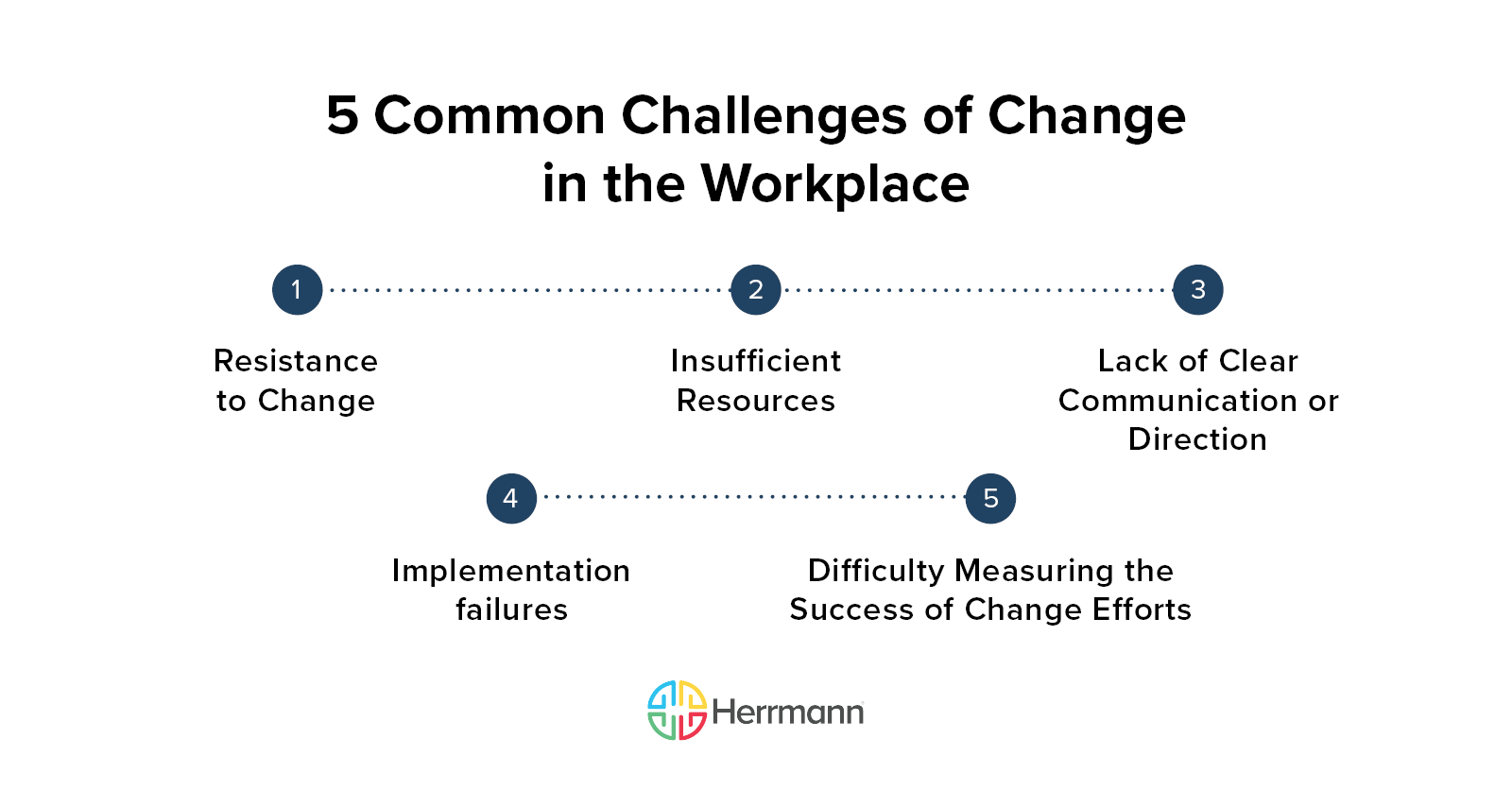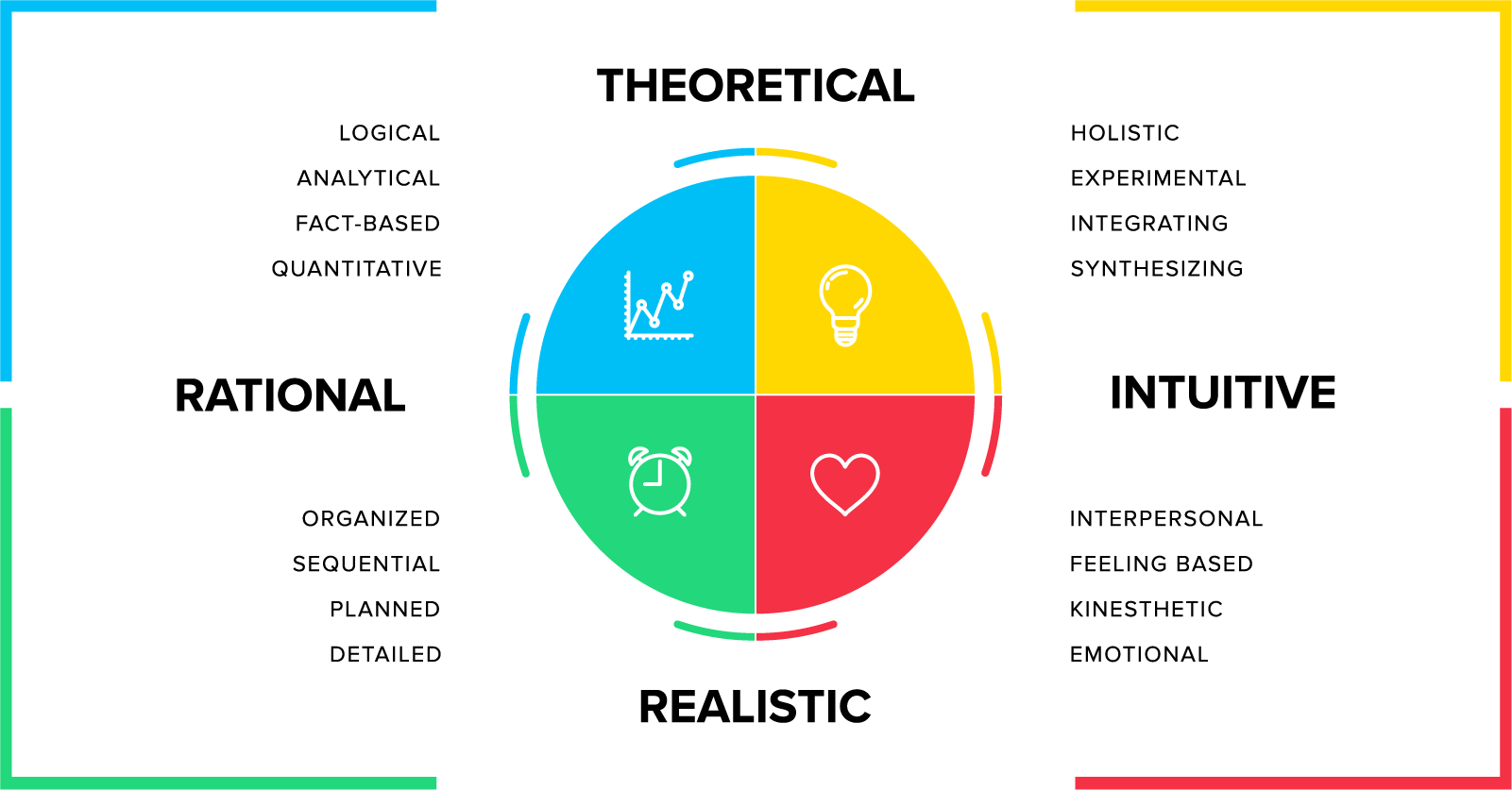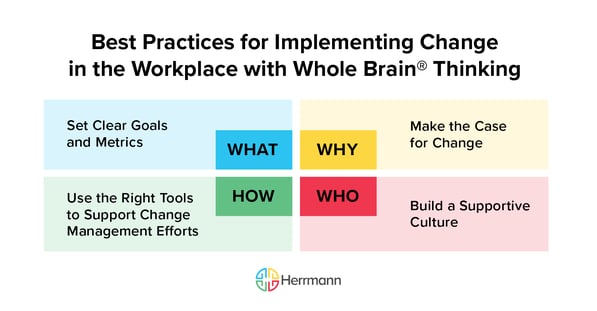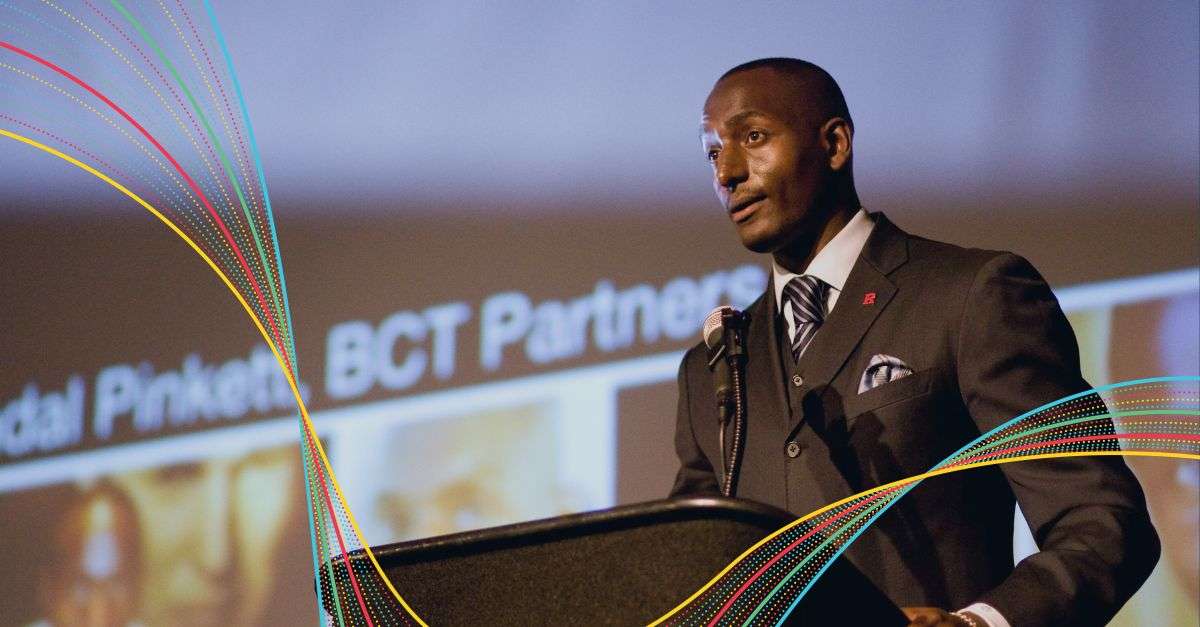If the only constant is change, then we have no choice but to learn how to change. But what does it mean to successfully navigate change in the workplace? And what does that look like inside your teams?
We'll explore common challenges of managing change in the workplace, the benefits you can achieve, and offer tips for dealing with change based on the Whole Brain® Thinking model.
Why Is Embracing Change in the Workplace Important?
Great teams and organizations aren’t static. They evolve as people come and go, as work processes and technology develop, and as industry trends shift.
Change is often discussed in terms of massive shifts — a new CEO, reorganizations, new lines of business mergers and acquisitions. While those are important examples, change occurs in small, everyday ways. Think of things like filling out new paperwork, onboarding a co-worker, learning new technology, or adjusting to a new boss.
Everyone experiences change differently. Some people are afraid of change, while others are always looking to, as Facebook founder Mark Zuckerberg once said, “Move fast and break things.” For most employees, their reaction depends on the circumstances. Our comfort level with change depends on our experiences, the information we have, and how we expect the change to affect us.
Changes in the workplace are inevitable. Organizations can anticipate them and make adjustments, or they can ignore them and hope for the best. How your organization and leaders approach change will affect business outcomes, employee engagement and retention, and the quality of your team’s thinking.
5 Common Challenges of Managing Change in the Workplace
If change were easy, everyone would do it. Organizational change requires people to adopt different mindsets, but the brain loves routine. It naturally seeks and organizes around patterns and mental maps you’ve developed in your thinking throughout your life.
Sometimes these maps are helpful; sometimes they’re not. Most change requires that we challenge our mental maps and form new connections in the brain — and this takes energy and motivation. A well-structured change management system can help transition individuals, teams, and organizations from the current state to a desired future state.
However, not all organizations practice change management well. Let’s look at some of the common challenges of creating workplace change.
Resistance to Change
Any change initiative is bound to face some form of resistance. There are many causes, including employees who are comfortable with the status quo or who are concerned about their job security.
Every level of the organization is a potential harbor for resistance, starting with your executive team. For any change initiative to be successful, your top leaders must be on board and committed in their words and actions (i.e., resources and budgets).
If your leadership team won’t back the changes, neither will your managers or front-line employees. Other sources of resistance include your customers, clients, or other business partners, especially if they feel left out of the process or negatively affected.
Insufficient Resources
Sign up to our newsletter for the latest insights
When you’re short on resources, you must prioritize which changes are most essential and focus on achieving those first. In some cases, you might seek out external funding or partners who can fill resource gaps or create efficiencies.
Lack of Clear Communication or Direction
Because change is disrupting the status quo, your people need to understand what’s changing and — equally as important — what’s not changing.
Effective communication isn’t just a one-way stream of announcements, either. You’ll create confusion, frustration, and resistance when people feel excluded from the process. You create buy-in when you solicit their feedback, answer questions, and offer surveys.
Implementation failures
Change management isn’t just about the people. It’s about getting from point A (the current state) to point B (the future state). While change can be frustrating and even unwelcomed by employees, most will come around when the change event occurs.
A failed implementation can cause lasting damage to leadership credibility and team morale. You’re left picking up the pieces, and you still haven’t fixed the original problem.
Difficulty Measuring the Success of Change Efforts
An important part of change planning is setting clear goals, and those goals are stronger when you have clear data about the current state and the outcomes you hope to achieve. Ideally, you can easily measure progress along the way. Doing so allows everyone to understand how the change initiative is going and where adjustments need to be made.
Some change journeys are easier to measure than others. A digital transformation involving your customer relationship management (CRM) system, for example, might be relatively easy to measure. You can look at such metrics as customer agent productivity or sales performance over time. A company culture change, by contrast, might be measured through a combination of technology, surveys, and less structured feedback.

4 Benefits of Proactively Managing Change in the Workplace
Most change initiatives aren’t just because someone got bored. Usually, there’s an impetus: an opportunity for innovation, external disruption, a need to modernize technology or a leadership change in perspective.
Whatever is driving your change initiative, success manifests itself in powerful business results, including improvements in productivity, creativity, and innovation.
Let’s look at some of those benefits.
Increased Productivity and Efficiency
When done right, change contributes to increased productivity and efficiency. This is often the result of employees having better tools and processes to work with. For example, a company that implements a new CRM system may see improved customer service efficiency because team members can access all customer data in one place. Your sales team might be more productive because they spend less time entering data into fields and more time with their customers and clients.
Improved Employee Engagement and Job Satisfaction
Employee engagement, productivity, and agency are linked to each other. Change can leave employees disconnected. They might feel powerless to resist the changes or to contribute. By contrast, when employees understand what’s happening and how they can deliver change, they’ll regain their sense of agency. From there, they’ll be more productive and help drive successful change.
You don’t need every employee to be in love with every aspect of change. But if they understand what’s happening and what role they’ll play, you’ll see the results.
Better Team Thinking
When employees are more engaged and productive, they’ll be more connected with each other. Change can bring together your team of unique thinkers because, despite their differences, they share the same goals. That understanding fuels collaboration and better ideas, which very well could make a difference in the change initiative’s success.
Better Alignment With the Organization's Goals and Mission
Employee and team engagement both roll up to the larger goal of aligning with the company’s goals and mission. Organizations must remember to keep employees connected to company values, which rarely change the way processes or strategies do. Having that North Star can help employees keep focus even in the face of severe disruption.
A Whole Brain Approach to Change Management
Herrmann's approach to change management is based on the Whole Brain® Thinking model. The premise is that organizations are most effective when they use all four quadrants of the brain: analytical, structural, relational, and experimental thinking processes.
Each quadrant represents a different style of thinking and decision-making, and each has its strengths and weaknesses. Remember that there’s no one quadrant that’s incompatible with a change mindset.
By understanding and using all four quadrants, organizations can learn how to manage change at work more effectively.

Here’s how change might manifest in each quadrant of the Whole Brain® Thinking model:
- A (Blue) Quadrant: People exercising this thinking preference approach the challenge with a more logical, analytic, quantitative, and bottom-line approach to change. They might be less comfortable with the emotions and feelings created by the unknown.
- B (Green) Quadrant: People exercising this thinking preference gravitate toward planned, organized, detailed and sequential change. They might feel a lack of security and be uncomfortable with new approaches that changes may bring.
- C (Red) Quadrant: People exercising this thinking preference operate in interpersonal, emotional, kinesthetic, and feeling change modes. They want conversations about change but might be prone to reacting before understanding all of the facts at hand.
- D (Yellow) Quadrant: People exercising this thinking preference embrace synthesizing, integrating, holistic, and intuitive change modes. As excited as they are about change, they might feel confined or worry about a potential loss of freedom.
If your team is heavily attuned to D Quadrant (Yellow) thinking, your people might already be comfortable suggesting change and thinking differently about problems. Other people, however, don’t feel comfortable there and naturally embrace other preferences.
If you are reading this as someone with a low preference for Yellow thinking, for example, that’s OK. You can be an effective change leader. You just might have to be more intentional about exercising that thinking preference.
Another powerful way Whole Brain® Thinking improves team thinking is by framing problems in terms of questions that ask what, why, who, and how. Each of those questions applies to everyone while also mapping to specific quadrants.
For example, if you’re trying to help your team re-evaluate its mindset to embrace change, you might ask questions in the following ways:
- What's your current mindset? (Blue)
- Why do you hold this mindset? What’s keeping you from breaking out of it? (Yellow)
- How's your current mindset different from those of other people? (Red)
- How can you change or modify your current mindset to improve results? (Green)

Best Practices for Implementing Change in the Workplace with Whole Brain® Thinking
When implementing change in the workplace, there are several best practices to keep in mind as you move through each stage.
Make the Case for Change
Leadership must communicate to all relevant stakeholders why the changes are necessary. This message should be repeated regularly and in different forms — a town hall announcement is OK, but also make change goals accessible on demand.
Keeping in mind Whole Brain® Thinking preferences, make the case for change from more than one perspective. Explain what’s happening, why it’s happening, who'll be affected, and how the change will happen. Here’s how that might look in the thinking preference represented by each quadrant:
- Blue Quadrant: Sharing facts and research that explain the change’s merits and potential.
- Green Quadrant: Showing what resources are available and how the change will occur.
- Red Quadrant: Sharing how the change aligns with organizational values while checking in on how people feel.
- Yellow Quadrant: Illustrating the big picture and showcasing the “why” behind the change.
Set Clear Goals and Metrics
Having measurable goals helps communicate the change initiative more clearly at the outset. As you progress, clear goals help everyone understand what they’re trying to achieve — and whether you’ve succeeded.
Avoid “vanity metrics” that look and sound impressive but don’t demonstrate how you’re moving from the current state to the future state. That said, while Blue and Green thinkers might gravitate toward hard numbers or see how their work generates the right metrics, Red thinkers might question whether the metrics account for the people doing the work. And Yellow thinkers might need a detailed explanation of why these particular goals or metrics were chosen.
Build a Supportive Culture
The Red Quadrant of Whole Brain® Thinking is especially concerned with how people are feeling and how they’re affected by the change. A supportive company culture is one in which employees feel comfortable taking risks, trying new things, and speaking up.
A culture of trust and respect isn’t just about making people feel good. Such cultures empower better processes (Green), honest evaluations of progress and data (Blue), and exploration of big ideas (Yellow). Creating a supportive culture is itself a change initiative that can be the foundation for other change management efforts.
Use the Right Tools to Support Change Management Efforts
Change management is increasingly about having the right digital tools and the most efficient processes. The Whole Brain® Thinking model can be a helpful tool in this regard by helping teams better understand their thinking and how everyone’s thinking preferences work well together.
From a technology perspective, project management systems go a long way toward determining how effective your change efforts are. Managing projects through technology meets the Green preference for order and process while generating data and analytics that Blue thinkers want to see. Project management tools satisfy the Red Quadrant by showing how everyone fits into the project and what their role is. The overall order and explanation help Yellow thinkers explore without getting disconnected from the “why?” of the change initiative.
Take a Whole Brain Approach to Workplace Change
One of the most important — and challenging — components of change in the workplace is helping people adjust their mindsets. Herrmann's Whole Brain® Thinking model provides a framework for leaders to assess their thinking preferences, as well as the thinking preferences of their team members. With this understanding, your teams are better prepared to embrace change and turn their differences into advantages.
Want to know more? Learn about creating resilient leadership development programs to navigate change.












